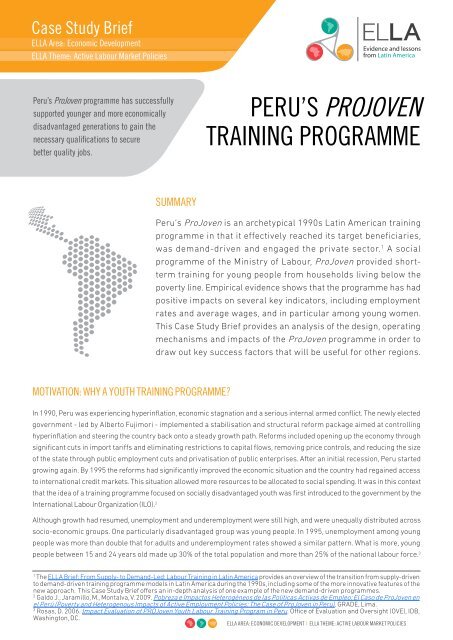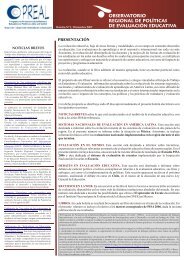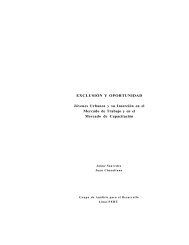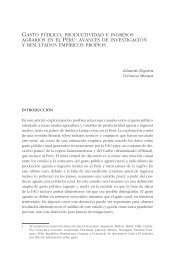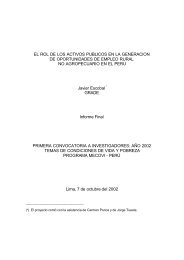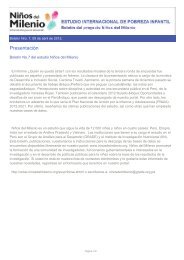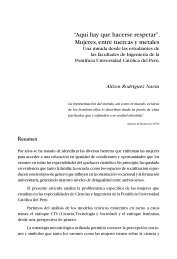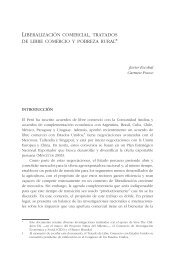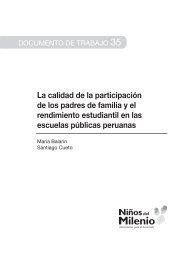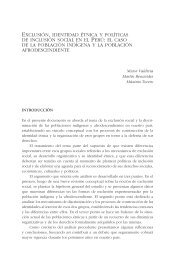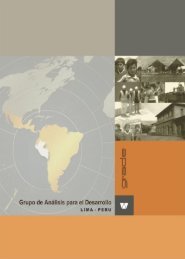PERU'S PROJOVEN TRAINING PROGRAMME
PERU'S PROJOVEN TRAINING PROGRAMME
PERU'S PROJOVEN TRAINING PROGRAMME
Create successful ePaper yourself
Turn your PDF publications into a flip-book with our unique Google optimized e-Paper software.
Case Study BriefELLA Area: Economic DevelopmentELLA Theme: Active Labour Market PoliciesPeru’s ProJoven programme has successfullysupported younger and more economicallydisadvantaged generations to gain thenecessary qualifications to securebetter quality jobs.PERU’S <strong>PROJOVEN</strong><strong>TRAINING</strong> <strong>PROGRAMME</strong>SUMMARYPeru’s ProJoven is an archetypical 1990s Latin American trainingprogramme in that it effectively reached its target beneficiaries,was demand-driven and engaged the private sector. 1 A socialprogramme of the Ministry of Labour, ProJoven provided shorttermtraining for young people from households living below thepoverty line. Empirical evidence shows that the programme has hadpositive impacts on several key indicators, including employmentrates and average wages, and in particular among young women.This Case Study Brief provides an analysis of the design, operatingmechanisms and impacts of the ProJoven programme in order todraw out key success factors that will be useful for other regions.MOTIVATION: WHY A YOUTH <strong>TRAINING</strong> <strong>PROGRAMME</strong>?In 1990, Peru was experiencing hyperinflation, economic stagnation and a serious internal armed conflict. The newly electedgovernment - led by Alberto Fujimori - implemented a stabilisation and structural reform package aimed at controllinghyperinflation and steering the country back onto a steady growth path. Reforms included opening up the economy throughsignificant cuts in import tariffs and eliminating restrictions to capital flows, removing price controls, and reducing the sizeof the state through public employment cuts and privatisation of public enterprises. After an initial recession, Peru startedgrowing again. By 1995 the reforms had significantly improved the economic situation and the country had regained accessto international credit markets. This situation allowed more resources to be allocated to social spending. It was in this contextthat the idea of a training programme focused on socially disadvantaged youth was first introduced to the government by theInternational Labour Organization (ILO). 2Although growth had resumed, unemployment and underemployment were still high, and were unequally distributed acrosssocio-economic groups. One particularly disadvantaged group was young people. In 1995, unemployment among youngpeople was more than double that for adults and underemployment rates showed a similar pattern. What is more, youngpeople between 15 and 24 years old made up 30% of the total population and more than 25% of the national labour force. 31The ELLA Brief: From Supply- to Demand-Led: Labour Training in Latin America provides an overview of the transition from supply-drivento demand-driven training programme models in Latin America during the 1990s, including some of the more innovative features of thenew approach. This Case Study Brief offers an in-depth analysis of one example of the new demand-driven programmes.2Galdo J., Jaramillo, M., Montalva, V. 2009. Pobreza e Impactos Heterogéneos de las Políticas Activas de Empleo: El Caso de ProJoven enel Perú (Poverty and Heterogenous Impacts of Active Employment Policies: The Case of ProJoven in Peru). GRADE, Lima.3Rosas, D. 2006. Impact Evaluation of PROJoven Youth Labour Training Program in Peru. Office of Evaluation and Oversight (OVE), IDB,Washington, DC.ELLA AREA: ECONOMIC DEVELOPMENT | ELLA THEME: ACTIVE LABOUR MARKET POLICIES
These statistics pointed to significant challenges in terms oflabour market insertion; consequently young people becamea priority target group in the labour policy agenda.During this period, there were also serious doubts about bothhow well the educational system prepared young people toface an increasingly dynamic and demanding labour market,and whether the public training system was doing enoughto keep up with the changing needs of the productive sector.This diagnosis suggested that there was a large variabilityin the quality of institutions that provided training and veryfew connections with the productive sector (Box 1). Privatecompanies complained that it was difficult to find personnelwith the necessary skills and that little information wasavailable about the quality of training institutions and thedemand for qualifications. 4 This pointed to significantstructural barriers, one of which was a mismatch betweendemand for and supply of skills.ABOUT <strong>PROJOVEN</strong>ProJoven emerged in 1996 as the Peruvian government’sresponse to the labour market diagnosis. The idea behind itwas not that more training was needed. This, of course, wastrue, but would only partially address the challenges thecountry faced. It was also true that a different type of trainingsystem was needed.ProJoven provided funding for training in basic or semi-skilledpositions in particular occupations. The vocational traininghad two main components: (1) a learning phase with trainingcourses directly provided by training institutions (Entidadesde Capacitación - ECAPs); and (2) an internship phase wheretrainees acquired on-the-job experience in a private firm.Beneficiaries attended the training courses for three monthswith costs covered by ProJoven. Later on, they worked forthree months and received a market wage paid by the firm,corresponding to their skill level. After the three months,the firm had the option to hire the trainee. Courses offeredincluded clothes manufacturing, cooking and gastronomy,hotel and tourism services, IT support, gas installations,logistics and warehouse management, industrial welding,mechanics and automotive electrical systems, foodindustry, electric installations, sanitary facilities installation,construction and sales, among others.Table 1 summarises the objectives and goals of theBox 1: Peruvian Training Institutionsin the 1990s: A Mixed BagA study carried out by the Ministry of Labour in 1996, basedon a nationwide survey of 1,112 graduates from 123 urbanTechnical Institutes (Institutos Superiores Tecnologicos - IST),showed that the Peruvian post-secondary educational systemwas characterised by substantial differences in terms ofquality. Moreover, the study found that this heterogeneity hadsignificant impacts on IST graduate earnings, with variancesbetween graduates from ISTs in Lima (the capital city) andthose from other Peruvian cities. For example, in Lima,graduates from a high quality IST were earning on average46% more than graduates from low quality ISTs; in other citiesthis difference was about 17%. Studies conducted by Valdivia(1994 and 1997) found a positive correlation between thesocioeconomic status of IST students and the quality of theinstitutions. That is, poorer young people tended to acquirepost-secondary education and training in lower qualityinstitutions than young people with higher socioeconomicstatus. In addition, several other studies using data fromthe 1990s have shown that there was a mismatch betweeneducation and training and current skill requirementsin terms of labour demand (Arregui 1993, Verdera 1995,Rodriguez 1996, Díaz 1996, Burga and Moreno 1999, Saavedraand Chacaltana 2001, Chacaltana and Sulmont 2004,Herrera 2005) . 5Within this context, ProJoven was intended to contribute tobuilding a more dynamic training market by promoting closerconnections between training entities and the productivesector. Notwithstanding, it is important to note that both theLabour Ministry and the Education Ministry share responsibilitiesfor post-secondary technical education in Peru. Collaborationbetween the two is therefore essential if structuralbarriers are to be removed over the long-term.Source: Díaz, J., Jaramillo, M. 2006. An Evaluation of the Peruvian“Youth Labour Training Program” - <strong>PROJOVEN</strong>. Inter-American Development Bank, Washington, DC.programme as it was initially designed. The programmetargeted young people between 16-24 years old fromeconomically disadvantaged backgrounds. Participation inthe programme was voluntary and registration took place ona first-come first-served basis at ProJoven headquarters orany of its decentralised offices. Among the programme’s maingoals was increasing employment rates and wages among4Ibid.5To access these studies, see: Díaz, J., Jaramillo, M. 2006. An Evaluation of the Peruvian “Youth Labour Training Program” - <strong>PROJOVEN</strong>.Inter-American Development Bank, Washington, DC.ELLA AREA: ECONOMIC DEVELOPMENT | ELLA THEME: ACTIVE LABOUR MARKET POLICIES 2
is the only step where training institutions intervene in theselection of participants and which does not have standardprocedures, since each institution operates by its own rules.Figure 2: Beneficiary Selection ProcessSource: Galdo J., Jaramillo, M., Montalva, V. 2009. Pobreza e ImpactosHeterogéneos de las Políticas Activas de Empleo: El caso de ProJovenen el Perú (Poverty and Heterogenous Impacts of Active EmploymentPolicies: The Case of ProJoven in Peru). GRADE, Lima.IMPACT EVALUATIONSBetween 1996 and 2012, ProJoven provided training toapproximately 78,318 individuals. It is possible to assesswhether this training translated into employment and higherwages because a number of impact evaluations have beenconducted. ProJoven works by launching consecutive calls(‘rounds’) for participants and training institutions (ECAPs),and the programme has expanded coverage gradually overthe years to different regions of the country. This stageddevelopment has meant that periodic impact evaluationshave been carried out, generating data on a range of indicatorsat different stages. This information has been crucial forredefining strategies and making improvements.To estimate impacts, diverse non-experimental techniqueshave been used, from the propensity score matchingtechnique (PSM) that aims to match beneficiaries and non-beneficiary individuals on the basis of observable relevantcharacteristics, such as sex, age, schooling, poverty leveland place of residence, to the traditional difference-indifferenceimpact estimator, which compares differencesbefore and after the training amongst the beneficiary andnon-beneficiary groups. Table 2 summarises the impacts onincome of ProJoven taken from a number of studies usingdifferent impact evaluation techniques.The studies show that returns were higher in the first rounds(between 100% and 39%) as compared with the 4th and 6throunds (13% - 54%). Also, higher impacts on income aremostly observed in the first 6 months after the training. Thisfirst point is explored by Díaz and Jaramillo (2006). 8 Theyfound that the impacts of ProJoven on monthly earningsdecreased between the first and fourth round (1996-1998)and then rebounded and grew from the sixth to eighth round(1999-2000), thus presenting a U-shape. 9 Based on theseresults, they conclude that the programme has been relevantfor young people, in particular by providing quality trainingto individuals that otherwise would have not acquired labourtraining or would have acquired lower quality training.Besides this, the Díaz and Jaramillo paper - as well as others- evaluates impacts on other relevant indicators such asemployment, probability of getting a paid job and hoursworked. In general, the studies find significant and positiveimpacts on all indicators, especially for women, whose impactresults were systematically higher. The reason for this maybe the fact that women in Peru face greater barriers foradequate labour market insertion. 10 In this context, effectivetraining programmes may represent an appropriate policy forreducing gender gaps in the labour market.Effects on the employment rate were on average 13%, andthey were higher for women (20%) than for men. Training alsoincreased the likelihood of workers finding jobs in the formallabour market by 11% on average and, likewise, this effectwas larger for women than for men by 9 percentage points.Finally, the probability of getting paid employment aftertraining increased by between 17% and 20%, although resultswere not always significant.8Díaz, J., Jaramillo, M. 2006. An Evaluation of the Peruvian “Youth Labour Training Program” - <strong>PROJOVEN</strong>. Inter-American DevelopmentBank, Washington, DC.9Although the authors do not provide an explanation of these round-to-round variations, they may be related to self-selection of beneficiariesin the first round and may also be a result of cyclical effects (such as course design responding to current labour market demand or labourmoving with the business cycle for specific sectors).10Galdo, J., Jaramillo, M., Montalva, V. 2009. Pobreza e Impactos Heterogéneos de las Políticas Activas de Empleo Juvenil: El Caso dePROJoven en Perú (Poverty and Active Employment Policies Heterogeneous Impacts: The Case of ProJoven in Peru). Working Paper 54.GRADE, Lima.ELLA AREA: ECONOMIC DEVELOPMENT | ELLA THEME: ACTIVE LABOUR MARKET POLICIES4
Table 2: Impacts on Monthly Income (% increase) 11StudyRoundÑopo, Robles and Saavedra (2002) 12 6th 13%Monthly Income IncreaseBy month 6 By month 12 By month 18Burga (2003) 13 2nd 100%Chacaltana and Sulmont (2003) 14 2nd 45% n.s 40%4th 38% 54% 51%Díaz and Jaramillo (2006) 15 1st 60% 44% 39%Note: n.s. = non-significant.Own elaboration.Other interesting findings include the impacts of trainingby gender and poverty levels. Galdo et al 16 found a highheterogeneity in the distribution of impacts amongsocioeconomic quintiles and large differences betweenmen and women, with women tending to experience greaterimpacts. They also found that training institutions, and notpoverty levels of beneficiaries, seemed to be the cause ofthis variation. No evidence suggested that poorer peopleamong the poor benefited less from the programme, that is,participants benefited from the programme independently oftheir socioeconomic status. 17Finally, Ñopo, Robles and Saavedra (2002) examined the impactsof the programme on labour market gender segregation.Gender segregation 18 refers to certain occupations beingpredominantly reserved for a particular gender, either male orfemale. The results indicated that ProJoven led to a significantreduction of 20% in the occupational segregation index of thebeneficiary group.COSTS AND BENEFITS OF THE PROJECTThe Ñopo, Robles and Saavedra report (2002) also provideda detailed analysis of the overall costs and benefits ofProJoven. Direct costs included training, bursaries, subsidiesand administrative costs. Bursaries covered lunch andtransportation expenses and subsidies were provided foryoung women with children. Administrative costs includedthe wages of temporary and permanent staff, and goods andservices. Total direct costs for the sixth round (1999) werearound US$ 1.865 million and the number of beneficiaries was3,585, giving an average cost per beneficiary of US$ 520.Opportunity costs represent the income that participants stopreceiving under the assumption that they leave their jobs toparticipate in the programme. This is not necessarily the case,however, since it was possible for participants to continuewith some paid work outside of the training programme.With this in mind, the opportunity costs for the sixth round ofparticipants were calculated assuming that any previouslyemployed participants would stop receiving wages equivalentto 270 hours of work (the average duration of theoreticalcourses in the learning phase). On this basis, the opportunitycosts represented 3.34% of direct costs (US$ 55,885).Benefits received by participants included bursaries and subsidiesas well as wages during their 3 month internship inthe practical phase. Furthermore, the programme has beenshown to have positive effects on employability, hours workedand income. Additional benefits that should be taken intoconsideration include structural changes in the training marketand improvements in quality standards, non-observablebenefits for young people such as self-esteem, and social benefitssuch as a reduction in crime. Finally, study results indicatedthat the internal rate of return (IRR, or average annualreturn of investment) was between 13% and 36%.11Hourly wage was used by Ñopo, Robles and Saavedra (2009).12Ñopo, H., Robles, H., Saavedra, J. 2002. Una Medición del Impacto del Programa de Capacitación Laboral Juvenil ProJoven (An ImpactAssessment of the Youth Labour Training Programme PROJoven). Working Paper 36. GRADE, Lima.13Burga, C. 2003. Re-evaluando PROJoven: Propensity Score Matching y una Evaluación Paramétrica. CEDEP, Lima.14Chacaltana, J., Sulmont, D. 2003. Políticas Activas en el Mercado Laboral Peruano: el Potencial de la Capacitación y los Servicios deEmpleo (Active Policies in the Peruvian Labour Market: The Potential for Training and Employment Services). CIES, Lima.15Díaz and Jaramillo provide income impacts for up to the 8th round, though for simplicity, we only include results for the first. Pleasesee the full paper for more detail on income impacts: Díaz, J., Jaramillo, M. 2006. An Evaluation of the Peruvian “Youth Labour TrainingProgram” - <strong>PROJOVEN</strong>. Inter-American Development Bank, Washington, DC.16Ibid17Ibid18Ñopo, Robles and Saavedra 2002, above n9.ELLA AREA: ECONOMIC DEVELOPMENT | ELLA THEME: ACTIVE LABOUR MARKET POLICIES5
CONTEXTUALFACTORSENABLING PERU’SSUCCESSFUL RESPONSEBy 1995 Peru was resuming growth after inflation had beenbrought under control and reforms had significantly improvedthe fiscal outlook. This situation allowed more resources to beallocated to social spending. It was in this context that the ideaof a training programme focused on socially disadvantagedyouth was first considered. Although growth had resumed,unemployment and underemployment were still high, as wellas being unequally distributed across socioeconomic groups. Oneparticularly disadvantaged group was youth, with unemploymentrates more than double that for adults, which explains why thisbecame a priority target group for Peruvian public officials.The role of international agencies was important in supportingthe development of ProJoven. The ILO and the United NationsDevelopment Programme (UNDP) funded the first studiestowards the design of the programme, while the IDB soon cameon board and provided technical and financial assistance to thewhole design phase. This technical support was key because itenabled experiences from other Latin American youth trainingprogrammes (most notably in Argentina, Chile and Uruguay),which the IDB had helped fund, to be incorporated into ProJovenprogramme design. The IDB also funded a pilot experience thatwas vital for generating evidence on the potential impacts of theprogramme. Finally, IDB funding was critical in the design phase ofthe programme because it facilitated the contracting of technicalexpertise required to ensure the programme design was sound.LESSONS LEARNED1 2The Peru experience demonstratesthat training programmes arenot easy sells politically. Thoughrigorous evaluation of the pilotprogramme provided evidence ofpositive social returns, it was notenough to push public officials toapprove full-scale implementation.Possible reasons include competinguse of resources for other socialinterventions, the fact that traininghas less visibility than, for instance,infrastructure investment, andthe returns to training are lessimmediate than, for instance, anemployment programme. Thisunderscores the importance ofhaving a strategy to ‘sell’ the ideato politicians and public officials.3Overall, ProJoven provides a successfulmodel for tackling structural unemploymentwhich may especially affect middle- and lowskilledyouth. Targeting this disadvantagedgroup while promoting development ofthe training market helped to improveconnections between labour supply anddemand, producing benefits for society morebroadly. Demand-driven mechanisms - suchas public calls for participants and traininginstitutions - can promote competitivenessand higher standards in the trainingmarket. They can also motivate traininginstitutions to form partnerships with privatefirms and tailor their courses accordingly.ProJoven’s lessons on design andimplementation suggest that effectivetargeting requires both self-selection45(short courses, for instance, will notattract the well-off) and socio-economicassessment. Furthermore, targetingpoor female youth can help to reducegender segregation in the labour market.Large impacts on income may disguisethe fact that initial incomes of beneficiariesare very low. Higher investment perbeneficiary should be considered to supportyoung people to move out of poverty.Adapting lessons from existingprogrammes enriched the designprocess, with ProJoven built onexperiences from similar programmesin Chile, Argentina and Uruguay. Accessto adequate technical staff was alsocrucial and was facilitated by the IDB.CONTACT GRADETo learn more about this case, contact the author, Miguel Jaramillo, PhD,Principal Researcher – GRADE, who has written extensively about labourissues in Latin America, at mjaramillo@grade.org.pe.FIND OUT MORE FROM ELLATo learn more about active labour market policies, read the ELLA Guide,which has a full list of knowledge materials available on this topic. Tolearn more about other development issues, browse other ELLA Themes.ELLA is supported by:ELLA AREA: ECONOMIC DEVELOPMENT | ELLA THEME: ACTIVE LABOUR MARKET POLICIES6


